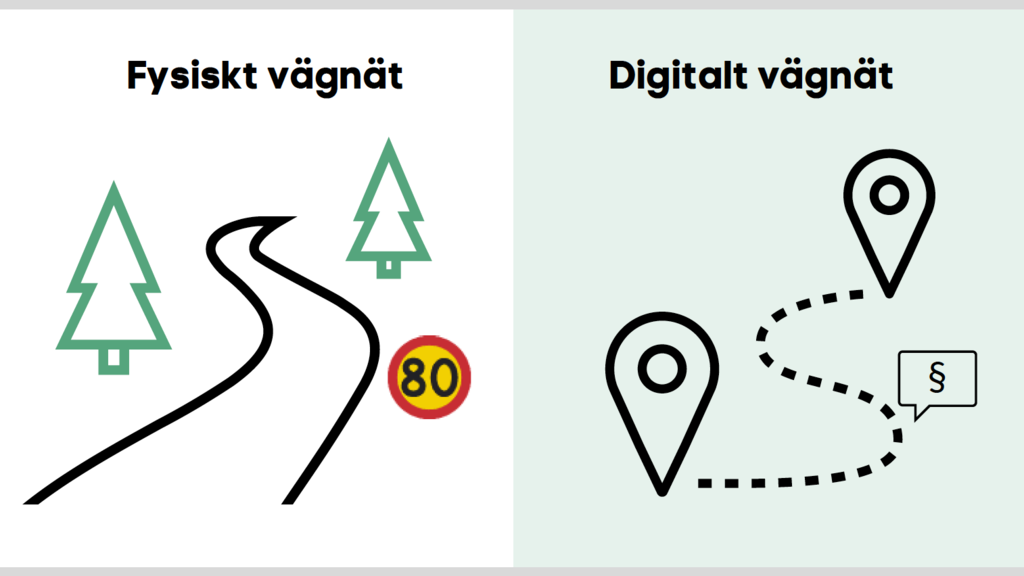Traffic rules of the future
The project addressed the need for development of the regulatory framework for traffic regulations – work that needs to be carried out through dialogue with a wide range of actors. In the project, which is part of the Drive Sweden Policy Lab, information was gathered about the needs and benefits of digital and machine-readable information about traffic rules, conditions and challenges leading up to a change and ongoing work in Sweden and at the EU level. As a result, the project has landed in the fact that the traffic regulations need to change.

Within the framework of the project, possible solutions and consequences of different options have been discussed. The project has not been able to quantify the benefit to society of the available data on traffic rules within the framework of this project, but has described the benefits and assesses that they can potentially be very large. Some effects are also difficult to calculate, but are nevertheless of great importance. However, the many needs and benefits of traffic regulation data that have been identified suggest that the benefits outweigh the costs to society.
The purpose of the project has been to investigate a future system of traffic regulations through a policy lab to manage regulations and decision-making processes. This has been done together with actors from the entire value-chain who are affected by future traffic regulations. A prerequisite for being able to solve the issue was to gather the actors affected by the issue and through collaboration try to reach a well-balanced solution. We have therefore used policy lab as a method to find forms for a way forward that can support the development towards a connected and automated road transport system.
Conclusions in selection
The transport sector is becoming increasingly connected, digitized and automated. Development is taking place at a rapid pace and has the potential to improve the transport system in several areas, such as increased safety, higher efficiency, lower environmental impact and increased accessibility. But to meet the development, we need to develop and adapt the digital infrastructure. Part of this is digital and machine-readable traffic rules. In a more digital world, we will need data about traffic rules - what applies where.
Through a process together with a number of different actors, the project has reached, among other things, these conclusions:
- Data on traffic rules is needed for a range of applications already in use today, such as navigation, routing and intelligent speed enforcement. It is also needed for more easily accessible information about, for example, parking, loading and charging in an increasingly complex society. In the long term, it is also needed to enable, for example, automated driving, geofence applications and dynamic traffic regulation. As the transport system becomes more automated and connected, the need for reliable and easily accessible digital information about traffic rules will increase. We have not been able to quantify the societal benefits of the available data on traffic rules within the framework of this project, but we have described the benefits and estimate that they are potentially very large. Some effects are also difficult to calculate, but are nevertheless of great importance.
- There is an intrinsic benefit for the decision-making authorities in working digitally in connection with traffic regulation and the data that is created can be used for various needs within the cities/authorities.
- We have a good starting position. There are already technical and practical opportunities to link digital information to traffic regulations, and many municipalities and the Swedish Transport Administration use these opportunities.
- However, major efforts are needed if data on traffic rules is to become more complete and reliable on the entire road network. Neither the market nor a central authority such as the Swedish Transport Administration can solve this satisfactorily on their own. More decision-making authorities must adopt digital solutions for traffic regulations and the processes for producing the traffic regulations also need to become more uniform.
- New requirements for decision-making authorities could be introduced, for example in the regulation (2007:231) on electronic announcement of certain traffic regulations where there are already mandatory requirements for the decision-making authorities about when, where and how traffic regulations must be announced. A constitutional amendment for mandatory digitization is judged to have a large effect (increasing digitization).
- The 'no changes' alternative – to do nothing – means that the problems with a lack of digital information remain and the benefits for society are absent or postponed.
- All in all, a constitutional amendment for mandatory digitization appears to be the best alternative.
Final report and presentation
Video with conclusions
In December 2022 the project presented parts of the conclusions. See the event here! (in Swedish)
Watch the presentation from Drive Sweden Forum,
Mars 2023
The project is a part of Drive Sweden Policy Lab
Final presentation
Time period
September 2021 - December 2022
Contact
Cilli Sobiech
cilli.sobiech@ri.se
Partners
Trafikverket, Adtollo, Sokigo, Norconsult, Astando, KP Kostnads- och Planeringssystem, Triona, HERE Europé B.V., TomTom International, Einride
Vinnova number
2021-03294


